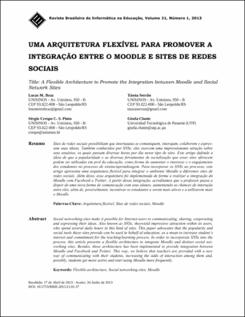Mostrar el registro sencillo del ítem
A Flexible Architecture to Promote the Integration between Moodle and Social Network Sites
| dc.contributor.author | de Clunie, Gisela T. | |
| dc.contributor.author | Crespo, Sérgio | |
| dc.contributor.author | Braz, Lucas | |
| dc.contributor.author | Serao, Tassia | |
| dc.date.accessioned | 2018-03-13T13:12:54Z | |
| dc.date.available | 2018-03-13T13:12:54Z | |
| dc.date.issued | 01/01/2013 | |
| dc.date.issued | 01/01/2013 | |
| dc.identifier.issn | 1414-5685 | |
| dc.identifier.uri | http://ridda2.utp.ac.pa/handle/123456789/4409 | |
| dc.description | Social networking sites make it possible for Internet users to communicating, sharing, cooperating and expressing their ideas. Also known as SNSs, theywield impressive attraction within its users, who spend several daily hours in this kind of sites. This paper advocates that the popularity and social tools these sites provide can be used in behalf of education, as a mean to increase student’s interest and commitment for the teaching/learning process. In order to incorporate SNSs into the process, this article presents a flexible architecture to integrate Moodle and distinct social networking sites. Besides, these architecture has been implemented to provide integration between Moodle and Facebook and Twitter. This way, we believe that teachers are provided with a new way of communicating with their students, increasing the odds of interaction among them and, possibly, students get more active and start using Moodle more frequently. | en_US |
| dc.description.abstract | Social networking sites make it possible for Internet users to communicating, sharing, cooperating and expressing their ideas. Also known as SNSs, theywield impressive attraction within its users, who spend several daily hours in this kind of sites. This paper advocates that the popularity and social tools these sites provide can be used in behalf of education, as a mean to increase student’s interest and commitment for the teaching/learning process. In order to incorporate SNSs into the process, this article presents a flexible architecture to integrate Moodle and distinct social networking sites. Besides, these architecture has been implemented to provide integration between Moodle and Facebook and Twitter. This way, we believe that teachers are provided with a new way of communicating with their students, increasing the odds of interaction among them and, possibly, students get more active and start using Moodle more frequently. | en_US |
| dc.format | application/pdf | |
| dc.language | eng | |
| dc.language.iso | eng | en_US |
| dc.rights | https://creativecommons.org/licenses/by-nc-sa/4.0/ | |
| dc.rights | info:eu-repo/semantics/openAccess | |
| dc.subject | flexible architecture | en_US |
| dc.subject | Social networking sites | en_US |
| dc.subject | Moodle | en_US |
| dc.subject | flexible architecture | |
| dc.subject | Social networking sites | |
| dc.subject | Moodle | |
| dc.title | A Flexible Architecture to Promote the Integration between Moodle and Social Network Sites | en_US |
| dc.type | info:eu-repo/semantics/article | |
| dc.type | info:eu-repo/semantics/publishedVersion |
